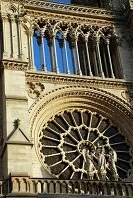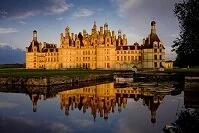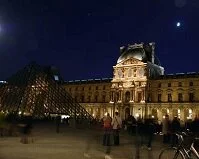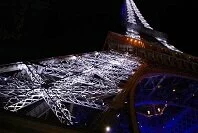
Gothic Notre Dame in Paris
Again, the best examples of Gothic architecture in France are churches, including many of France's most famous monuments. Paris's Notre-Dame (1100s) and Sainte-Chappelle (1200s) are both Gothic churches, however neither was truly revolutionary in the movement itself. Many consider the Chartres Cathedral (1100s) the premier example of French gothic and perhaps the most authentic building in this style anywhere. The Bourges Cathedral (1100-1200s), Amiens Cathedral (1200s), and Notre-Dame (1200s) in Reims are also incredible works of art that continue to represent the Gothic age in the present.
Two other notable examples of Gothic art are Mont-Saint-Michel (1000-1500s), which is an island containing a church by the same name just off the coast in Normandy and the city of Albi, which is considered an excellent example of southern French Gothic.
In the 1400s the Renaissance arrived in France, but without as much fanfare as the Gothic movement brought. The Renaissance style came from Italy and many Italian architects were brought into the country to erect these monuments, however the gothic style continued on throughout this time period and many of the introductions from the Renaissance movement only came as alterations on the gothic as opposed to an entirely new style in many buildings.

Chambord Castle
Most of the true Renaissance buildings in France are in the Loire Valley as the capital was in Tours at the time, or were built as retreats for the French kings. Unlike the gothic style, most of the buildings erected in the Renaissance style were palaces or chateaus built for royalty. The Chateau de Blois (1200-1600s), Chateau de Chambord (1519-1547), Chateau d'Ancy-le-Franc (mid-1500s), Chateau d'Ecouen (mid-1500s), and the Chateau de Chantilly (mid-1500s) are all excellent examples of the style.
The Palace of Fontainebleau (1500s) is the final example of the French version of Renaissance art. The Palace of Fontainebleau was built with Rome in mind and altered the Italian Mannerism style to suit French tastes. Its style then influenced numerous other buildings throughout France.
The Baroque, and later Rococo movements really took hold in France and today there are a huge number of buildings in these styles. This begins with the world renowned Palace of Versailles (1600s) just outside of Paris. However, Versailles was only one of many palaces or chateaus built during the time. The Luxembourg Palace (1615) in Paris and Chateau de Vaux-le-Vicomte (1658-1661) in Maincy are also in this style.

Louvre in Paris
The Baroque style was also used in the construction of forts, such as the Fortifications of Vauban (1633–1707), in civic buildings such as L'Hotel national des Invalides (1670-1679) in Paris, and in churches such as Val-de-Grâce (1645) in Paris, which may be the most committed to the Baroque style of all French churches.
In the 1700s a number of changes took place in France that vastly altered the architectural landscape. As civil unrest spread, Napoleon took over power and soon brought with him a dominating style to symbolize his power and strength, that of ancient Rome. This movement of Classicism and neo-Classical architecture dominated much of France during the late 1700s and much of the early 1800s, but extended even into the 1900s.
This new style was introduced in nearly every type of building, from civic buildings to churches and even hotels. The Arc de Triomphe (early 1800s) and the many buildings along the adjacent Champs-Elysees in Paris were built as megalithic monuments. The School of Medicine (1769–1776) in the University of Paris (or Sorbonne), the Opera House (1862-1875) in Paris, and the Library of Sainte-Genevieve (1843-1850) in Paris are all in this style. Likewise, the Pantheon in Paris (1757–90, originally built as a church) also dictates Napoleon's goals and feelings of power.

Eiffel Tower in Paris
By the late 1800s new technology and building techniques encouraged new building styles and designs that were not possible previous to this time. The most famous of these monuments is the Eiffel Tower (1887-1889) in Paris. In the early 1900s Art Nouveau also became popular as much of the Paris Metro reflects this time period.
Obviously, France offers more for the architectural aficionado than nearly any other country and trying to see every significant monument would take months. The best over all cities to see the entire span of French architecture begins with Paris, which contains buildings in nearly every style and more landmarks than most countries have in their entirety. Bordeaux also has a huge number of buildings that can be considered architectural giants, as can Strasbourg. Nearly every small town and village also tends to offer a more rural and local French feel as the architecture doesn't tend to be as grandiose, but remains quite impressive, especially in coordination with the landscape and village charm.